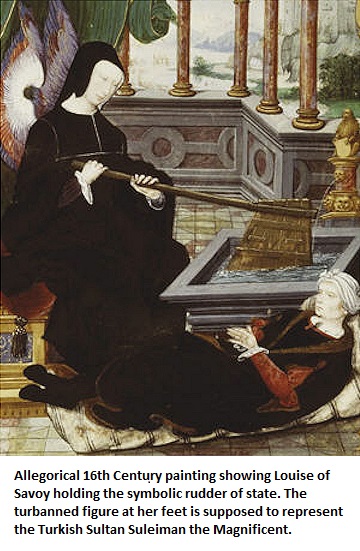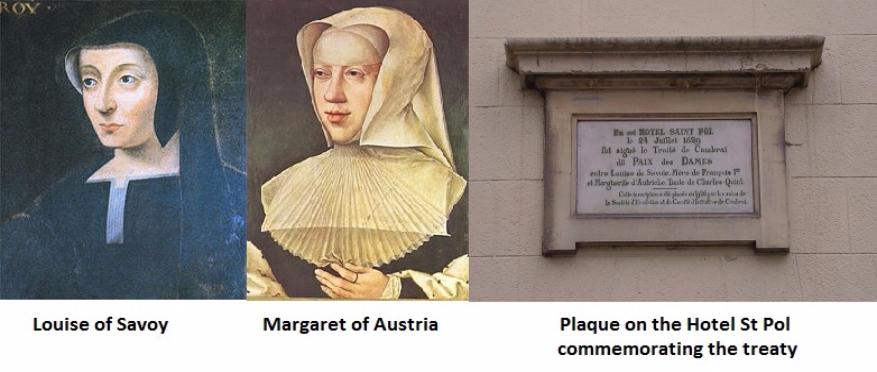TAKING THE RUDDER - LOUISE OF SAVOY & THE PAIX DES DAMES
During the Middle Ages the ‘Salic Law’ of France didn’t just bar women from the French throne. The laws of the Salian Franks, which dated back a thousand years, prohibited women from inheriting land of any type but this didn’t prevent Louise of Savoy from shaping the destiny of her country.
Louise was the eldest child of the Duke of Savoy and though Salic Law meant her younger brother Philibert would inherit this powerful Alpine dukedom, Louise was destined for something far greater than a ducal coronet. When she was just 7 her mother, Margaret of Bourbon, died so little Louise was sent to Paris to be brought up by the French royal court. Married off at 11, Louise was a widow by the age of 19 but her marriage produced two children: Marguerite [b.1492] and Francis [b.1494].
Thanks to a series of fortuitous dynastic deaths, the four year old Francis became heir presumptive to the French throne in 1498 and in preparation for their royal lives, the cultured and educated Louise schooled BOTH her children in the new learning of the Renaissance. In time Marguerite and Francis would become famous for their patronage of the arts and sciences but when he became king in 1515, Francis’ first duty was to continue the fight against France’s hereditary foes.
In the first half of the 16th Century France was under constant threat of invasion from the Hapsburg Holy Roman Emperor Charles V (who was also King of Spain and Italy) and Henry VIII King of England. Both these monarchs claimed large chunks of French territory but at a time when Francis needed friends his mother’s attempts to remarry added the Constable of France to her son’s list of enemies.
In 1521 Suzanne, the young Duchess of Bourbon died, and though Louise wanted to use the vast wealth of the ‘Bourbon Inheritance’ to fund her son’s wars, under Salic Law Suzanne’s rich ancestral lands belonged to her surviving husband. Through her mother, Louise was herself a Bourbon, and had it not been for Salic Law she might’ve had a good claim to possess these lands in her own right, but as she couldn’t overturn the ancient laws of inheritance the 45 year old queen tried to wed the recently widowed duke. Unfortunately the Duke of Bourbon was 14 years her junior and he rebuffed Louise’s advances. Insulted, the furious queen ordered the arrest of her reluctant suitor but Bourbon fled to Italy and joined the hated Hapsburg and English kings in their plot to conquer France.
Bourbon declared himself to be the true King of France and in return for English and Spanish support for his rebellion he agreed to Charles and Henry’s demands to divide France equally between themselves. In 1524, to further their ambitions, the rebel French duke besieged Marseille with an army of imperial mercenaries, paid for with English gold. Francis duly led his own army south to defend his realm but, after chasing his enemies back over the Alps, he was defeated and captured at the Battle of Pavia [1525]. From his Spanish dungeon Francis’ wrote to his mother ‘all is lost save honour’ but whilst the French court was thrown into panic, Louise kept her head.
With France now even more vulnerable to invasion, Louise sent ambassadors to London with orders to buy off Henry VIII. Under the Treaty of the More (named after Cardinal Wolsey’s Hertfordshire castle in which it was signed) Louise agreed to pay Henry £20,000 every year if he abandoned his Hapsburg alliance. The duplicitous Henry agreed and having successfully neutralised the threat from England Louise set about brokering another alliance - one that she hoped would crush the Hapsburgs for ever.
In late 1525 Louise sent ambassadors east with letters of friendship she’d written to the Ottoman Sultan Suleiman the Magnificent and though the first French embassy was lost in the mountains of Bosnia, a second reached the Turkish capital safely. Later, emboldened by Louise’s offer of French support, Suleiman invaded and conquered Christian Hungary and though the secret Franco-Ottoman alliance scandalised all Christendom when its existence was eventually revealed, it would persist until Napoleon invaded the Ottoman province of Egypt 250 years later.
Meanwhile, her son Francis was still a Spanish prisoner so Louise sent her daughter Marguerite to plead for her brother but, in spite of his mother and sister’s frantic diplomacy, Francis was forced to sign the humiliating Treaty of Madrid [1526]. To secure his release, Francis had to abandon French claims to Burgundy, Flanders, Italy and Navarre and send his two sons to the imperial court as hostages. However, as soon as Francis was back on French soil, he tore up the treaty and renewed the war. Francis fared no better in this conflict than the first, and the Treaty of Cambrai [1529], that ended the fighting was another humiliation for France.
Louise had also negotiated this treaty, hence its alternative name of the Paix des Dames (see previous post) but she was now in her fifties and just two years later she was dead. In 1531, true to her Renaissance upbringing, the ageing French queen caught a fatal chill after she’d stepped outside to get a better look at a comet but her royal legacy lived on. Louise’s grandchildren by her son Francis, and her great-grandchildren by her daughter Marguerite, all succeeded to the French throne and her royal line was only extinguished by the guillotines of the French Revolution.
The wars of the early 16th Century form the setting for my new book The Devil's Band (to order click here)

THE PAIX DES DAMES - A FAMILY AFFAIR
The catastrophic defeat suffered by the French army at the Battle of Pavia [1525] did not end the bloody wars between the Hapsburg Holy Roman Emperor (and king of Spain) Charles V and the Valois kings of France for control of Burgundy, Flanders and Italy. Though Francis I, the French king captured on the battlefield of Pavia, had been released from his Spanish dungeon after he’d signed the peace of Madrid, he immediately repudiated his treaty with Charles and recruited a new army.
The next three years of fighting became known as the War of the League of Cognac and though Francis managed to secure alliances with Pope Clement VII, the Venetian Doge and the Duke of Milan (all of whom feared Charles V’s growing power) the French were no more successful in this war than before. Even the brutal sack of Rome by imperial mercenaries in 1527, which finally brought Henry VIII of England into the war on the side of the French, failed to turn the tide and by 1529 Francis’ armies had been defeated and scattered for the second time in less than five years.
The French king sued for peace and the subsequent treaty was negotiated by a queen and a princess. For the French, the king’s mother Louise of Savoy entered the diplomatic lists whilst her sister-in-law Margaret of Austria spoke on behalf of her nephew the Emperor Charles of Hapsburg. The two ladies met in the border town of Cambrai in July 1529 and the sumptuous palace chosen for their meeting, the Hotel St Pol, belonged to another of Louise’s relatives Mary of Luxembourg.
Amidst the feasting and celebrations due to their rank, the negotiations proceeded swiftly and a new treaty was signed on the 5th of August (though some sources say the 3rd). The terms of the Paix des Dames (the Peace of the Ladies) required Francis to renounce his claims to Flanders, Artois and Italy, he also had to pay a sum of £2 million gold crowns to ransom his sons who were still being held as imperial hostages under the moribund treaty of Madrid! In return, Charles had to renounce his claims to Burgundy.
It’s tempting to imagine Louise and Margaret rapping Charles and Francis over the knuckles and telling them to play nicely but sadly not even these two imperious ladies could end the bitter Italian Wars. Fighting soon broke out again and continued intermittently until 1559 by which time both Francis and Charles were cold in their graves.
